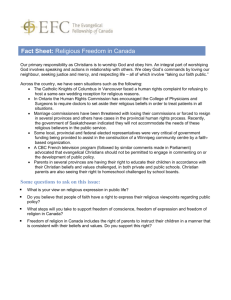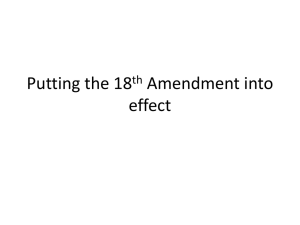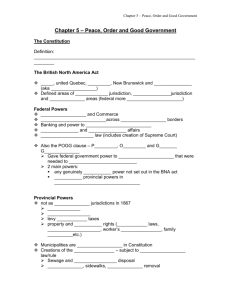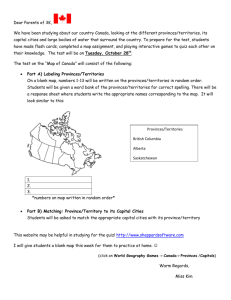Measuring Government Growth in the Canadian Provinces
advertisement
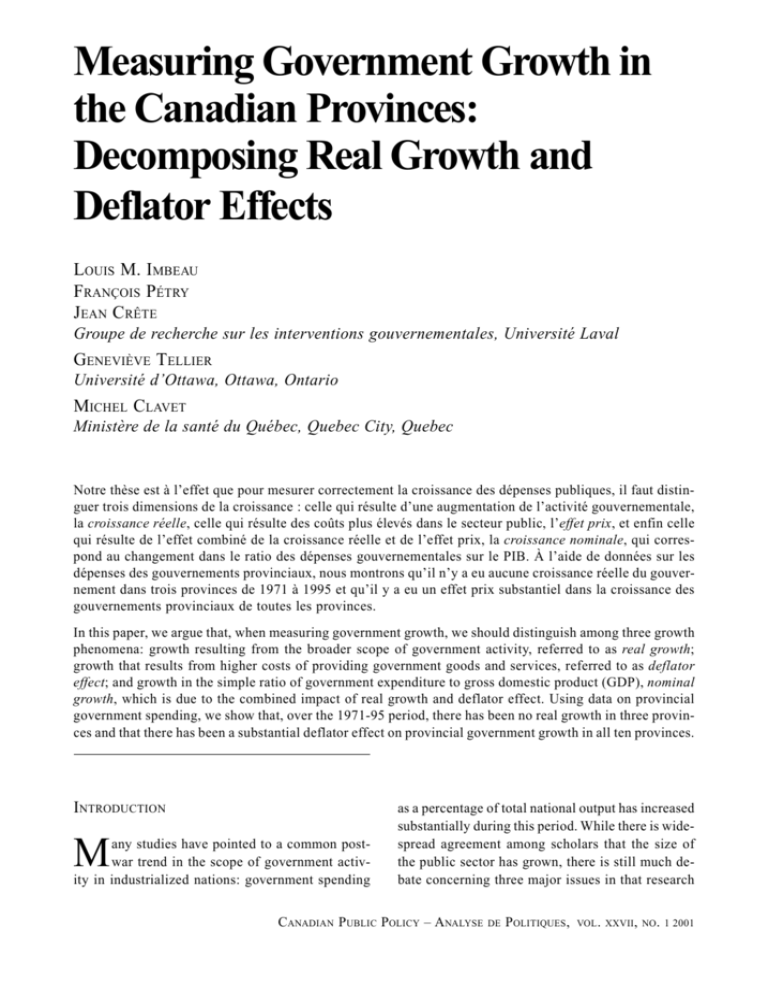
Measuring Government Growth in the Canadian Provinces: Decomposing Real Growth and Deflator Effects Measuring Government Growth in the Canadian Provinces 39 LOUIS M. IMBEAU FRANÇOIS PÉTRY JEAN CRÊTE Groupe de recherche sur les interventions gouvernementales, Université Laval GENEVIÈVE TELLIER Université d’Ottawa, Ottawa, Ontario MICHEL CLAVET Ministère de la santé du Québec, Quebec City, Quebec Notre thèse est à l’effet que pour mesurer correctement la croissance des dépenses publiques, il faut distinguer trois dimensions de la croissance : celle qui résulte d’une augmentation de l’activité gouvernementale, la croissance réelle, celle qui résulte des coûts plus élevés dans le secteur public, l’effet prix, et enfin celle qui résulte de l’effet combiné de la croissance réelle et de l’effet prix, la croissance nominale, qui correspond au changement dans le ratio des dépenses gouvernementales sur le PIB. À l’aide de données sur les dépenses des gouvernements provinciaux, nous montrons qu’il n’y a eu aucune croissance réelle du gouvernement dans trois provinces de 1971 à 1995 et qu’il y a eu un effet prix substantiel dans la croissance des gouvernements provinciaux de toutes les provinces. In this paper, we argue that, when measuring government growth, we should distinguish among three growth phenomena: growth resulting from the broader scope of government activity, referred to as real growth; growth that results from higher costs of providing government goods and services, referred to as deflator effect; and growth in the simple ratio of government expenditure to gross domestic product (GDP), nominal growth, which is due to the combined impact of real growth and deflator effect. Using data on provincial government spending, we show that, over the 1971-95 period, there has been no real growth in three provinces and that there has been a substantial deflator effect on provincial government growth in all ten provinces. INTRODUCTION M any studies have pointed to a common postwar trend in the scope of government activity in industrialized nations: government spending as a percentage of total national output has increased substantially during this period. While there is widespread agreement among scholars that the size of the public sector has grown, there is still much debate concerning three major issues in that research CANADIAN PUBLIC POLICY – ANALYSE DE POLITIQUES, VOL . XXVII , NO. 1 2001 40 Louis M. Imbeau, François Pétry, Jean Crête, Geneviève Tellier and Michel Clavet program: the relevance of various explanations of government growth (Tarschys 1975; Borcherding 1977; Larkey, Stolp and Winer 1981; Delorme and André 1983; Hood 1991; Holsey and Borcherding 1997), the way we should go about empirically testing these explanations (Cameron 1978; Lowery and Berry 1983; Kau and Rubin 1981), and the appropriate measure of the scope of government activity (Beck 1976, 1979; Berry and Lowery 1984a, 1984b; Heller 1981; Pétry et al. 2000). This paper is a contribution to this last debate. The issue of choosing the appropriate measure of government size is an important one because government may grow — more specifically, the ratio of government spending to gross domestic product (GDP) may rise — for two reasons: the scope of government activity may become larger as a result of an increase in the amounts and types of goods and services offered, and the cost of providing a constant level of goods and services may increase at a different rate in the public sector than in the private sector. Thus, we have three government growth phenomena that we should distinguish: growth resulting from the broader scope of government activity, referred to as real growth; growth that results from higher costs of providing government goods and services, referred to as deflator effect; and growth in the simple ratio of government expenditure to GDP, nominal growth, which is due to the combined impact of real growth and deflator effect. To differentiate these three types of growth, one must use figures that are adjusted for the difference in price dynamics in the public and the private sectors as they are reflected in price indices. Several scholars have insisted on the importance of using differential price deflators for the public and the private sectors when measuring government size. Buchanan and Flowers (1987), for example, argued that the use of unadjusted values may seriously confound changes in prices with changes in government’s real share in economic activity. According to Lowery and Berry (1983) measures of government size that use the undeflated ratio of govCANADIAN PUBLIC POLICY – ANALYSE DE POLITIQUES, ernment spending to the total output of the economy artificially inflate the rate of growth of public expenditures because they ignore the effect of different price deflators for the public and private sectors on the ratio of government spending to economic output. For observers of government spending in Canada, the “deflator issue” raises an important question: whether the use of differential price indices for the public and the private sectors makes a difference in the inference one makes about the growth of government spending in the Canadian provinces. The answer to this question is particularly important for social scientists who try to explain the growth of government spending in industrialized societies since it concerns the actual measure of their dependent variable. Indeed, Cameron (1986) has shown that the inflation rate for the Canadian public sector is substantially higher than that found in the private sector, and Garand (1988, 1989, 1991) demonstrated that a substantial proportion of the growth in American state government size could be attributed directly to the different inflation rates for the public and private sectors. This raises the possibility that empirical tests for government growth models (and hence inferences drawn from such tests) may be contaminated by the use of an undeflated dependent variable that ignores the different rates of inflation for the private and public sectors. For example, scholars have shown that empirical support for government growth models, both in the United States (Berry and Lowery 1984a, b) and in the Canadian provinces (Pétry et al. 2000), depends on whether a deflated or undeflated measure of government size is employed. Looking at government spending in the United Kingdom, Mullard (1993) argued that the use of a price deflator specific to government spending had an important impact on inference made about the growth of government consumption expenditures. The deflator issue is also relevant in a context of government cutbacks because their magnitude is directly affected by the measure of government size VOL . XXVII , NO . 1 2001 Measuring Government Growth in the Canadian Provinces that is used. If the price of providing goods and services in the public sector rises at a faster rate than in the private sector, the ratio of government expenditure to GDP may appear to grow, even though the scope of government activity may have decreased. More importantly, the means toward reducing the size of government depend critically on our ability to understand what forces influence government expansion in the first place. This raises the possibility that prescriptions for budgetary policy may be misleading because they are not based on a valid measure of government growth. Indeed policy prescriptions aimed at constraining real government growth may be quite different from those aimed at correcting a “deflator effect” on government spending. Our objective in this paper is to chart the pattern of government growth in the ten Canadian provinces and to assess the relative impact of deflator and real growth effects on the size of provincial governments since 1971. To achieve this objective, we first construct a measure of government size that is sensitive to the impact of differential price deflators for the public and the private sectors. We then estimate the separate effect of changes in the scope of governmental activity and differential price deflators on the growth of provincial governments and we isolate government growth effects that are due to the rising cost of the public sector. We show that, over the period under study, there has been no real growth in three provinces and that there has been a substantial deflator effect on provincial government growth in the other provinces. 41 always entails spending of public funds. Then, it is reasoned, much of the variation in the size of governments from one society to another can be captured by the changes in government spending one can observe (Hofferbert and Budge 1996; for an opposing view, see Heidenheimer 1996). Given the availability of financial statistics, it is of no surprise that social scientists have resorted to government spending as their preferred indicator of government size. For the most part, studies of government growth have measured government size by calculating public spending levels as a proportion of the level of economic output, most frequently GDP. We use a similar method to construct our first measure of government size in the Canadian provinces, denoted GOVSIZE: GOVSIZEt ≡ SPENDINGt / GPPt [1] where SPENDINGt represents total provincial and local government expenditure in current dollars and GPP t denotes gross provincial product in current dollars. This measure of government size is problematic in that it assumes that the price deflators (reflecting inflation rates) are equivalent for the public and the private sectors. Indeed, rearranging the terms of equation [1] using current dollar figures and correcting for inflation with a single inflation index would be equivalent to multiplying the figures by unity: (SPENDINGt / PRICEINDEXt) / (GPPt / PRICEINDEXt) GOVERNMENT GROWTH IN THE CANADIAN PROVINCES ≡ (SPENDINGt / GPPt) * (PRICEINDEXt / PRICEINDEXt) ≡ SPENDINGt / GPPt Measuring Government Size in Real Terms The most common measure of government size in the comparative public policy literature is government expenditures. Indeed, it is considered that government activity (be it legislative, financial, discursive, administrative, coercive or event activity) [2] Our second measure of government size in the provinces is sensitive to the impact of differential price deflators for the public and the private sectors. Like the measure developed by Lowery and Berry (1983) it uses two different price deflators, CANADIAN PUBLIC POLICY – ANALYSE DE POLITIQUES, VOL . XXVII , NO. 1 2001 42 Louis M. Imbeau, François Pétry, Jean Crête, Geneviève Tellier and Michel Clavet one for government spending, the other for total economic output: DGOVSIZEt ≡ (SPENDINGt/GOVDEFt)/(GPPt/GPPDEFt) [3] or, rearranging equation [3] as we did in equation [2]: DGOVSIZEt ≡ (SPENDINGt/GPPt) * (GPPDEFt/GOVDEFt) [4] where DGOVSIZE represents the deflated measure of government size, GOVDEF is the deflator for provincial government expenditure, GPPDEF is the deflator for provincial economic output and SPENDING and GPP are as defined above. As we argued above, the use of such a measure gives a more valid picture of government growth in the Canadian provinces. Comparing deflated and undeflated measures will allow us to see whether the growth in government spending that provincial states have experienced in recent decades really corresponds to an increase in the scope of government activity or to the difference in the cost of providing goods and services in the public and the private sectors. Our experiment is based on data coming from Provincial Economic Accounts published by Statistics Canada and covering the 1971-95 period. “Provincial” government spending (SPENDING) includes exhaustive expenditures (government current expenditure on goods and services and government investment) and transfer payments (transfers to persons, to business, and interest on public debt) of both provincial and local levels of government. 1 Price indices (1986 = 100) are allowed to vary both over time (from year to year) and over space (from province to province). More details are provided in the following paragraphs and in the Appendix. Data on real provincial government spending are provided by Statistics Canada only for exhaustive expenditures: government current expenditures on goods and services and government investments. Statistics Canada statisticians use various methods to compute these figures. Constant dollars figures CANADIAN PUBLIC POLICY – ANALYSE DE POLITIQUES, on salaries, which make up about two-thirds of government consumption expenditures, are computed using prices of the reference period combined with employment volume of current periods. In most other cases, real-term data are computed using price indices originally elaborated for other purposes but which are considered to be relevant for given categories of expenditures.2 These data are provided for every province, on a yearly basis, over the 1971-95 period.3 Unfortunately, Statistics Canada provides no information on provincial government transfer expenditures in real terms. Therefore, one must look for ways of transforming nominal figures into real ones. We chose to follow the standard procedure and to deflate components of transfer spending using relevant price indices already published by Statistics Canada. A good price index of provincial transfer payments should measure price movements in the goods and services that are bought with the money transferred. Thus, transfers to households are deflated with the implicit price index-personal expenditure on consumer goods and services (IPIPE), since these transfers mostly serve to buy current consumption goods and services. With regard to transfers to firms, we distinguish two sets of expenditures: (i) transfers for equipment, which are deflated using the implicit price index-business investment in machinery and equipment (IPIBI); (ii) general subsidies, used by firms for all sorts of production and consumption activities, which are deflated using the implicit price index-final domestic demand (IPIFDD), since it is not possible to know how recipients spend the money transferred. Finally, because it is equally impossible to know how recipients of interest payments on public debts spend the money thus transferred— not to mention the fact that an important part of these transfers is done outside a given province — we deflated debt service expenditures using the implicit price index-final domestic demand (IPIFDD). Figures 1A and 1B display the evolution of government size in the Canadian provinces from 1971 to 1995. These figures show that, if there was a VOL . XXVII , NO . 1 2001 FIGURE 1A 85 87 89 91 93 95 CANADIAN PUBLIC POLICY – ANALYSE DE POLITIQUES, .18 71 .20 .22 .24 .26 .28 73 75 77 79 81 83 85 Nova Scotia 87 89 91 93 95 .20 .22 .24 .26 .28 .30 .32 .22 83 .24 71 81 .24 .26 79 .26 .28 77 .28 .30 75 .30 .32 73 .32 .34 Newfoundland 71 71 73 73 75 75 Plots of Nominal and Real Government Size by Province, 1971-1995 77 77 81 83 85 79 81 83 85 87 87 New Brunswick 79 Prince Edward Island 89 89 91 91 93 93 95 95 .22 .24 .26 .28 .20 .32 .34 71 73 75 79 Legend: 77 81 85 87 89 Real (1971$) Nominal 83 Quebec 91 93 95 Measuring Government Growth in the Canadian Provinces 43 VOL . XXVII , NO. 1 2001 FIGURE 1B CANADIAN PUBLIC POLICY – ANALYSE DE POLITIQUES, VOL . XXVII , NO . 1 2001 81 83 85 79 81 83 85 Saskatchewan 79 87 87 89 89 91 91 93 93 95 95 .20 .22 .24 .26 .28 .30 .32 .34 71 .16 77 77 .20 75 75 .20 .22 .24 .26 .28 .30 .32 .34 .18 73 73 Ontario .22 .24 .26 .28 .30 .32 .34 .36 .18 71 .20 .22 .24 .26 .28 71 71 73 73 Plots of Nominal and Real Government Size by Province, 1971-1995 75 75 77 77 79 79 83 85 81 83 85 Alberta 81 Manitoba 87 87 89 89 91 91 93 93 95 .16 .18 .20 95 .22 .24 .26 71 73 75 79 Legend: 77 81 85 87 89 Real (1971$) Nominal 83 British Columbia 91 93 95 44 Louis M. Imbeau, François Pétry, Jean Crête, Geneviève Tellier and Michel Clavet Measuring Government Growth in the Canadian Provinces growth, it was not a steady one. There were ups and downs that reflect changes in both government spending and GPP. The deflator effect is illustrated in our graphs by the difference between the opaque part of the graph (real size) and the upper line (nominal size).4 Looking at these figures, one is bound to conclude that there is, indeed, a deflator effect on the measures of government size. Let us remember that both measures correct for inflation. The nominal figure assumes a similar price dynamic in the public and the private sectors. Real figures take into account a different price dynamic in the public sector. The white area under the nominal size curve represents the deflator effect. It appears that inferences made about government size in the Canadian provinces over the 1971-95 period are bound to be influenced by the indicator of government size one uses. This influence will be smaller in Newfoundland and Nova Scotia, where the deflator effect appears to be smaller, and much larger in Prince Edward Island or in Saskatchewan. The graphs also show a common pattern in all provinces: the deflator effect increased over the 1970s, as shown by the increasing deflator effect area. In most provinces, the deflator effect remained relatively stable in the 1980s and the 1990s. Two exceptions can be noted: Saskatchewan and Alberta where the deflator effect somewhat decreased from around 1983 to 1995. It seems that in those two provinces the price dynamics in the public sector have evolved to become somewhat closer to that of the private sector, contrary to the other provinces where the difference remained constant. In summary, there is a deflator effect on measures of government size in all provinces and this effect varies from one province to the other as well as over time. But is there a deflator effect on trends? Indeed, having established that measures of government size are sensitive to a deflator effect, one may wonder whether the same effect exists on measures of government growth. 45 Trends in Provincial Government Growth To measure trends over time, a simple time-series regression of GOVSIZE and DGOVSIZE on time is used: GovSize = a1 + b1 (time) + e [5] DGovSize = a 2 + b2 (time) + e [6] where TIME is a simple counter going from 1 to 25 (one increment per year), a is the intercept and b the slope coefficient. We can interpret the slope coefficient as the annual rate of growth of government spending relative to the size of the economy over the 1971-95 period. If we multiply the slope coefficient by 100, we can interpret it in terms of percentage points. The two models were estimated for each province separately, for the 1971-95 period. Like Garand, we estimated our models in two steps. First, we determined the autocorrelation process in each model. Then we estimated each model using a procedure that takes into account the actual autocorrelation process.5 The differences observed in the plotted trends for the two measures of government size are verified in Table 1, where regression coefficients for the relationship between each measure and the time variable are reported. The slope coefficient (b1) for the undeflated measure is positive and significantly different from zero in nine provinces. But when using a deflated measure of government size, the slope coefficient (b2) remains positive and significant in only six provinces (Newfoundland, Nova Scotia, New Brunswick, Quebec, Manitoba, and British Columbia) but it is not significantly different from zero in the other provinces. In other words, we observe a growth in government spending of significant magnitude in nine provinces when no account is taken of differential price inflation in the public sector as compared to the private sector. But when the differential inflation is taken into account, government growth remains significantly positive in only six provinces. CANADIAN PUBLIC POLICY – ANALYSE DE POLITIQUES, VOL . XXVII , NO. 1 2001 46 Louis M. Imbeau, François Pétry, Jean Crête, Geneviève Tellier and Michel Clavet TABLE 1 Trends in Provincial Spending using Deflated and Undeflated Measures, 1971-1995 Province GOVSIZE b1 a1 Estimate Nfld. PEI NS NB Que. Ont. Man. Sask. Alta. BC Weighted average 0.2717 0.2464 0.2147 0.2244 0.2644 0.2029 0.2168 0.2412 0.2247 0.1885 DGOVSIZE Estimate 0.0019** 0.0021*** 0.0018*** 0.0031*** 0.0027** 0.0020** 0.0041*** 0.0033** 0.0018 0.0027*** Method s.e. 0.0007 0.0005 0.0003 0.0003 0.0008 0.0006 0.0005 0.0010 0.0018 0.0006 a2 Estimate AR(1) AR(1) AR(1) OLS AR(2) AR(2) AR(1) AR(1) AR(2) AR(1) 0.2749 0.2837 0.2228 0.2417 0.2854 0.2343 0.2411 0.2845 0.2611 0.2168 0.0022 b2 Estimate 0.0017* 0.0002 0.0014*** 0.0022*** 0.0015* 0.0003 0.0030*** 0.0013 0.0000 0.0012* Method s.e. 0.0006 0.0003 0.0003 0.0005 0.0007 0.0008 0.0003 0.0009 0.0017 0.0004 AR(1) AR(2) AR(1) AR(1) AR(2) AR(2) OLS AR(1) AR(2) AR(1) 0.0008 Notes: * p<.05; ** p<.01; *** p<.001. Source: See text. In all provinces the slope coefficient is of greater magnitude for undeflated measures than for deflated ones, with a weighted mean of 0.0022 for the former and 0.0008 for the latter. In other words, the size of government has increased by 0.22 percent yearly on average (5.5 percent over the 25-year period) if we do not take differential price inflation into account. If we do take differential price inflation into account, government size increased by 0.08 percent each year on average, or 2 percent over the period of analysis. 6 But can we measure the respective impact of real growth and deflator effects? Decomposing Real Growth and Deflator Effects The respective impact of real growth and deflator effects on government growth can be measured by comparing the slope coefficients for the deflated and undeflated time trends for government growth. Considering that the slope coefficients for deflated CANADIAN PUBLIC POLICY – ANALYSE DE POLITIQUES, expenditures as a proportion of GPP represent real growth in government activity and that the coefficients for undeflated expenditures represent total growth, it is straightforward to measure the proportion of total growth attributable to real growth in the scope of government activity by simply dividing the former coefficient by the latter. The impact of the deflator effect can then be measured by subtracting the real growth proportion from 1 (i.e., total growth) (Garand 1991). However, one problem arises when studying a period characterized by an absolute decrease of government spending, as we witnessed in several provinces in the 1990s. Looking at the Alberta graph, for example, we see that the downward slope in the last part of the period will make the time trend in both deflated and undeflated measures close to zero. Using the entire period would make it impossible to break apart the two components of total growth VOL . XXVII , NO . 1 2001 Measuring Government Growth in the Canadian Provinces (real growth and deflator effects). To circumvent that problem, we cut each provincial series at the point where total provincial-local government spending decreased in absolute terms. This occurred in Prince Edward Island, Nova Scotia, and Ontario in 1994, and in Manitoba, Saskatchewan, and Alberta in 1993. The series used to compute the deflator effect are 1971-93 for the former group of provinces, 197192 for the latter. As far as the other four provinces are concerned, no decrease in provincial-local government spending in absolute terms was observed. Therefore, we kept the complete series going from 1971 to 1995.7 Table 2 gives the estimated proportion of total growth attributable to real growth and to deflator effects for each province in periods of total spending growth between 1971 and 1995. These results suggest that we amend our previous conclusion. We do observe a nominal growth in all provinces, but a 47 real growth in only seven of them. Prince Edward Island, Ontario, and Alberta show no real growth in government spending. In those provinces, the deflator effect represents 100 percent of total growth. In the other seven provinces, the deflator effect ranges from 56 percent in British Columbia to 11 percent in Newfoundland. In these provinces, a substantial proportion of the total increase in the relative size of the public sector to the private sector cannot be assigned to real increases in the scope of government activity. Another important finding is the estimated proportion of the increase in total provincial-local government size that can be attributed to the effects of differential price deflators for the public and private sectors. On average, 65 percent of the growth in provincial-local government spending is not linked directly to an increase in the scope of government activity but appears to be due instead to TABLE 2 Total Growth, Real Growth, and Deflator Effect Components of Government Size in the Canadian Provinces for Periods of Growth in Total Spending Province Period Total Growth b1 Nfld. PEI NS NB Que. Ont. Man. Sask. Alta. BC Weighted average 1971-95 1971-93 1971-93 1971-95 1971-95 1971-93 1971-92 1971-92 1971-92 1971-95 Real Growth b2 1 Deflator Effect % b1-b2 % 0.0019** 0.0026*** 0.0021*** 0.0031*** 0.0027** 0.0015** 0.0050*** 0.0051** 0.0044** 0.0027*** 0.0017* 0.0000 0.0016*** 0.0022*** 0.0015* 0.0000 0.0033*** 0.0024** 0.0000 0.0012* 89 0 76 71 56 0 66 47 0 44 0.0002 0.0026 0.0005 0.0009 0.0012 0.0015 0.0017 0.0027 0.0044 0.0015 11 100 24 29 44 100 34 53 100 56 0.0026 0.0009 35 0.0017 65 Notes: * p < .05; ** p < .01; *** p < .001. 1b2 is equal to zero when the estimate is not significant at 0.10 (bilateral). Source: See text. CANADIAN PUBLIC POLICY – ANALYSE DE POLITIQUES, VOL . XXVII , NO. 1 2001 48 Louis M. Imbeau, François Pétry, Jean Crête, Geneviève Tellier and Michel Clavet the higher cost of goods and services produced by the public sector as compared to those produced by the private sector. The impact of the deflator effect accounts for an average yearly increase of 0.17 percent out of total yearly growth averaging 0.26 percent. Real growth has been limited to an annual average of 0.09 percent. It is clear that deflator effects matter in measuring government growth through public spending in the Canadian provinces, as they do in the American states. In fact, our estimate of the mean proportion of total government growth attributable to deflator effects in the Canadian provinces (65 percent) is even larger than Garand’s estimate for the American states (46 percent). Even in the province with the smallest estimated deflator effect (Newfoundland), 11 percent of total government growth appears to be accounted for by a higher inflation rate in the public sector relative to that in the private sector. We cannot accept anymore the idea that growth in provincial government spending is attributable solely to growth in the scope of government activity. Instead, we must recognize that growth in government expenditure as a proportion of GPP has two major components: (i) real growth, attributable to an increase in the scope of government activities and (ii) deflator effects, attributable to an increase in the prices of providing goods and services in the public sector as compared to the private sector. Our data show that these two components are present in the growth of provincial governments in Canada. DISCUSSION AND CONCLUSION Most people believe that the size of provincial governments has grown over past decades. This growth has been documented by many as being reflected in an increase in public spending relative to total provincial economic output. A more nuanced interpretation is possible if we decompose the growth in public spending into its scope and deflator CANADIAN PUBLIC POLICY – ANALYSE DE POLITIQUES, components. Using differential price indices for government expenditure and for GPP, we have shown that the use of an undeflated ratio of government expenditure to total economic output greatly overestimates the scope of government activity in the Canadian provinces. Increases in provincial government spending have been quite modest overall from 1971 to 1995 and the scope of government activity has even remained constant in three provinces. We also uncovered quite an important variation in deflator effect across provinces, and this is puzzling. Why is it that the differential in public and private price dynamics is so different from one province to the other? Beck (1976) argued that the lower productivity of the public sector — commonly referred to as Baumol’s disease — accounts for the increased relative costs of government goods and services. In his model, Baumol (1967) divides the economy into two sectors: the progressive and the non-progressive sectors. The non-progressive sector includes the service industries (government services, restaurants, performing arts, etc.), services that are labour intensive in their production. In this sector, “labour is itself the end product” (Baumol 1967, p. 416). This means that “since labour services are themselves part of the product that is being consumed, a reduction of the labour content [to increase productivity] would change the product that is being produced” (Brown and Jackson 1986, p. 117). But in the progressive sector, capital can be substituted for labour without affecting the nature of the product. Thus, cumulative increases in productivity can more easily arise from economies of scale and technological change. The result is a productivity differential between the two sectors. Since the improvements in labour productivity in the progressive sector are matched, in part, by increases in wages, the nonprogressive sector has to match these wage increases in order to prevent labour moving from the nonprogressive to the progressive sector of the economy. In other words, since government activity is mostly VOL . XXVII , NO . 1 2001 Measuring Government Growth in the Canadian Provinces of a non-progressive type, it costs the public sector more just to stand still. From this line of reasoning, one may hypothesize that the deflator effect is greater in provinces where the share of public administration employment to total employment is higher. The higher the proportion of labour employed in the public administration, the higher the costs derived from productivity differential between the public and the private sector. A similar hypothesis can be deduced from another theory, that of Buchanan and Tullock (1977), who contested Baumol’s explanation and argued instead that prices grow faster in the public sector because of the electoral power of bureaucrats. According to this theory, bureaucrats more or less keep politicians as hostages and exchange their electoral support for wage increases and other advantages. Consequently, as the number of public employees increases relative to the electorate in a province, pressures on wages in the public sector should be higher. Ceteris paribus, these pressures should be associated with a higher deflator effect. A third explanation can be derived from class analysis (Korpi 1983; Shalev 1983). According to this line of reasoning, prices grow faster in the public sector, where workers’ organizations (trade unions and social democratic parties) are typically stronger, because these organizations press for higher wages and advantages for their members. Therefore, one should observe higher pressures on public wages (and therefore higher deflator effect) in provinces where the vote for the New Democratic Party (NDP) is stronger and where the proportion of unionized labour is higher. It goes beyond the purpose of this paper to propose a serious test of these hypotheses. However, an exploratory analysis on data at hand shows that only the class analysis hypothesis seems to be confirmed by observation. Indeed, deflator effect is higher in provinces with lower employment in public administration as a proportion of active popula- 49 tion (r = –0.37), result that contradicts Baumol’s hypothesis. We found no correlation between public employment as a proportion of total provincial population and deflator effect (r = –0.13), which suggests that Buchanan and Tollock’s hypothesis is not supported either. Only in the case of the strength of the left did we find some support: deflator effect is higher where a proportion of the vote for, or of the seats won by, the NDP or the Parti Québécois (PQ) is higher (r = 0.41). Therefore, deflator effect seems to be more a consequence of class competition than of the characteristics that goods and services produced by the public sector take on or of the power of bureaucrats. This conclusion is tentative though as it is not based on the systematic tests that these hypotheses demand. An argument against deflating government spending with a specific government expenditure deflator is often made by scholars interested in cross-country comparisons of government growth. The objection revolves around the wide variations across countries in their procedures for deriving a deflator for government expenditure. Such wide variations render cross-country comparisons based on deflated measures a “questionable exercise” (Heller 1981). This line of argument may be valid for comparisons based on data independently generated by each government. This is not the case here since the provincial data we are comparing are compiled on a coherent basis by Statistics Canada. No matter how variations in differential costs are explained, they must enter into our measurement of government size. This study shows that not doing so may yield important biases in the inferences one can make from observing government activity through public spending. In light of this finding, several explanations of provincial government growth should be tested using undeflated and deflated measures of government size. This would allow for an assessment of whether the different strategies associated with the measurement of government size have an impact on the results obtained from empirical tests of government growth models. CANADIAN PUBLIC POLICY – ANALYSE DE POLITIQUES, VOL . XXVII , NO. 1 2001 50 Louis M. Imbeau, François Pétry, Jean Crête, Geneviève Tellier and Michel Clavet NOTES 1 The division of spending responsibilities between provincial and local governments in Canada falls into provincial constitutional jurisdiction; and provincial-local fiscal arrangements vary widely from one province to the next. For example, public spending at the local level represented 4.3 percent of total government spending in Newfoundland in 1993 and 18.9 percent in Ontario. This is why we use provincial-local spending (to which we added hospital spending) as a measure of government size in the provinces. Intergovernmental transfers are excluded to avoid double counting. All data come from Statistics Canada’s Provincial Economic Accounts (Cat. No 13-213). 2For a complete description and evaluation, see Tellier et al. 1997. 3Statistics Canada is undergoing an important reform of its economic accounts to make them closer to international criteria. From 1996 on, data are reported using the new methodology, so they are not comparable to the old series which will gradually be revised. We were told that the 1992-97 revised series are now available and that revised data going back to 1981 should be made available in the spring of 2000 (Lal 1994). In addition, we had problems finding data for gross provincial product. While there are data available from 1963 to 1996 for GPP in current dollars, there is no constant dollars figure available prior to 1981. Since our argument demands coherent series over the whole period under study, we used internal final demand (IFD) as a proxy for GPP. IFD is equal to GPP minus interprovincial trade. It is available in both current and constant dollars for the whole period. As far as real provincial expenditures are concerned, no data exist prior to 1971 and the last figure we could get was 1995. For all these reasons, we limit our study to the period 1971-95. 4As mentioned above, real government expenditures are in constant 1986 dollars. However, for the purpose of building these graphs only, we rescaled our data to constant 1971 dollars, thus making deflator effects clearer. 5As is argued by Ostrom (1978) and by Hibbs (1974), the examination of autocorrelation functions (ACF) and of partial autocorrelation functions (PACF) is the best way to determine the presence of residual autocorrelation and its order (be it auto-regressive, AR(p), moving average, MA(q), or both, ARMA(p,q)). In our data, most models follow an AR1 process. The exceptions are, for CANADIAN PUBLIC POLICY – ANALYSE DE POLITIQUES, GOVSIZE : Quebec (AR(2)), Ontario (AR(2)), Alberta (AR(2)), and for DGOVSIZE : PEI (AR(2)), Quebec (AR(2)), Ontario (AR(2)), and Alberta (AR(2)). There is no autocorrelation for New Brunswick (GOVSIZE), and for Manitoba (DGOVSIZE). Estimates were computed using SPSS ARIMA procedure in the presence of residual autocorrelation, and OLS procedure otherwise. 6The increases in the undeflated size of government over the 25-year period range from a maximum of 10.25 percent (Manitoba) to a minimum of 4.5 percent (Alberta and Nova Scotia). The maximum increase in the deflated size of government is observed in Manitoba (7.5 percent), while Alberta, Saskatchewan, Ontario, and Prince Edward Island exhibit no significant increase in the deflated size of government over the 1971-95 period. 7One could also consider splitting each provincial series into upward and downward trend periods. Fox example, the Alberta series could be divided into three periods: 1971-80 (downward), 1980-82 (upward), and 1982-95 (downward). This method would have two shortcomings. First, it would make many series too short for reliable estimates to be computed. Second, it would make the analysis too complex for a straightforward interpretation, especially when comparing provinces. REFERENCES Baumol, W.J. 1967. “Macroeconomics of Unbalanced Growth: The Anatomy of the Urban Crisis,” American Economic Review 57:415-26. Beck, M. 1976. “The Expanding Public Sector: Some Contrary Evidence,” National Tax Journal 29:15-21. ______ 1979. “Public Sector Growth: A Real Perspective,” Public Finance 34:313-53. Berry, W.D. and D. Lowery. 1984a. “The Growing Cost of Government: A Test of Two Explanations,” Social Science Quarterly 33:735-49. ______ 1984b. “The Measurement of Government Size: Implications for the Study of Government Growth,” Journal of Politics 46:1103-1206. Borcherding, T.E. 1977. “The Sources of Growth in Public Expenditure in the United States,” in Budgets and Bureaucrats, ed. T. Borcherding. Durham, NC: Duke University Press, pp. 45-70. Brown, C.V. and P.M. Jackson. 1986. Public Sector Economics. 3d ed. Oxford: Basil Blackwell. VOL . XXVII , NO . 1 2001 Measuring Government Growth in the Canadian Provinces Buchanan, J.M. and G. Tullock. 1977. “The Expanding Public Sector: Wagner Squared,” Public Choice 31:147-50. Buchanan, J.M. and M.R. Flowers. 1987. The Public Finances. Homewood, IL: Irwin Pub. Cameron, D.R. 1978. “The Expansion of the Public Economy: A Comparative Perspective,” American Political Science Review 72:1234-61. ______ 1986. “The Growth of Government Spending: The Canadian Experience in Comparative Perspective,” State and Society: Canada in Comparative Perspective, ed. K. Banting. Toronto: University of Toronto Press, pp. 21-51. Delorme, R. and C. André. 1983. L’État et l’économie. Essai d’explication des dépenses publiques en France. Paris: Éditions du Seuil. Garand, J.C. 1988. “Measuring Government Growth in the American States: Decomposing Real Growth and Deflator Effects,” American Politics Quarterly 86:40524. ______ 1989. “Measuring Government Size in the American States: Implications for Testing Models of Government Growth,” Social Science Quarterly 70:487-98. ______ 1991. “Decomposing Real and Deflator-Based Government Growth: An Application to American States,” Quality and Quantity 29:221-33. Heidenheimer, A.J. 1996. “Throwing Money and Heaving Bodies: Heuristic Calisthenics for Comparative Policy Buffs,” in Comparing Government Activity, ed. L.M. Imbeau and R.D. McKinlay. London: Macmillan. Heller, P. 1981. “Diverging Trends in the Share of Nominal and Real Government Expenditures in GDP: Implications for Policy,” National Tax Journal 34:61-75. Hibbs, D. 1974. “Problems of Statistical Estimation and Causal Inference in Time Series Regression Models,” in Sociological Methodology 1973-74, ed. H.L. Cortner. San Francisco: Jossey-Bass. Hofferbert, R.I. and I. Budge. 1996. “Patterns of PostWar Expenditure Priorities in Ten Democracies,” in Comparing Government Activity, ed. L.M. Imbeau and R. D. McKinlay. London: Macmillan. Holsey, C.M. and T.E. Borcherding. 1997. “Why Does Government’s Share of National Income Grow? An 51 Assessment of the Recent Literature on the U.S. Experience,” in Perspectives on Public Choice, ed. D.C. Mueller. London: Cambridge University Press, pp. 562-89. Hood, C. 1991. “Stabilization and Cutbacks: A Catastrophe for Government Growth Theory?” Journal of Theoretical Politics 3:37-63. Kau, J.B. and P.H. Rubin. 1981. “The Size of Government,” Public Choice 37:261-74. Korpi, W. 1983. The Democratic Class Struggle. London: Routledge. Lal, K. 1994. “The 1993 International System of National Accounts: Its Implementation in Canada,” in National Income and Expenditure Accounts, Cat. No. 13-001. Ottawa: Statistics Canada. Larkey, P.D., C. Stolp and M. Winer. 1981. “Theorizing About the Growth of Government: A Research Assessment,” Journal of Public Policy 1:157-220. Lowery, D. and W Berry. 1983. “The Growth of Government in the United States: An Empirical Assessment of Competing Explanations,” American Journal of Political Science 27:665-94. Mullard, M. 1993. The Politics of Public Expenditure. London and New York: Routledge. Ostrom, C. 1978. Time Series Analysis: Regression Techniques. Beverly Hills: Sage. Pétry, F., L.M. Imbeau, J. Crête and M. Clavet. 2000. “Explaining the Evolution of Government Size in the Canadian Provinces,” Public Finance Review 28:26-49. Shalev, M. 1983. “The Social Democratic Model and Beyond: Two ‘Generations’ of Comparative Research on the Welfare State,” in Comparative Social Research, ed. R.F. Tomasson. Greenwich: JAI Press. Statistics Canada. Various Years. Provincial Economic Accounts, Cat. No. 13-213. Ottawa: Supply and Services Canada. Tarschys, D. 1975. “The Growth of Public Expenditures: Nine Modes of Explanation,” Scandinavian Journal of Political Studies 10:9-31. Tellier, G., J.Crête, L.M. Imbeau and F. Pétry. 1997. Les dépenses publiques et la mesure de leur croissance réelle. Cahier du laboratoire d’études politiques No. 97-03. Sainte-Foy: Université Laval. CANADIAN PUBLIC POLICY – ANALYSE DE POLITIQUES, VOL . XXVII , NO. 1 2001 52 Louis M. Imbeau, François Pétry, Jean Crête, Geneviève Tellier and Michel Clavet APPENDIX TABLE A1 Data Sources and Variable Definitions Current Figures 1986 Figures Current expenditures (CE) Cat. 13-213 Cat. 13-213 Government investments (GI) Cat. 13-213 Cat. 13-213 Transfers to persons (TP) Cat. 13-213 computed using IPI*-personal expenditures on consumer goods and services (IPIPE) Transfers to firms – equipment (TFE) Cat. 13-213 computed using IPI-business investment in machinery and equipment (IPIBI) Transfers to firms – general subsidies (TFGS) Cat. 13-213 computed using IPI-final domestic demand (IPIFDD) Debt-service expenditures (DES) Cat. 13-213 computed using IPI-final domestic demand (IPIFDD) Final domestic demand (FDD) Cat. 13-213 Cat. 13-213 Government expenditures Exhaustive expenditures Transfer expenditures Notes: Implicit price index (IPI) provided by Statistics-Canada in Cat. No. 13-213. Price indices are allowed to vary both through time and across province. Variable definitions: GOVSIZE = (CE + GI + TP + TFE + TFGS +DES) / FDD DGOVSIZE = (CE86 + GI86 + TP/IPIPE + TFE/IPIBI + TFGS/IPIFDD + DES/IPIFDD) / FDD86 Source: Statistics Canada (various years). CANADIAN PUBLIC POLICY – ANALYSE DE POLITIQUES, VOL . XXVII , NO . 1 2001


